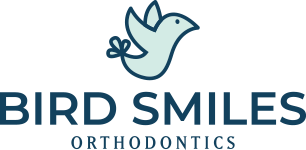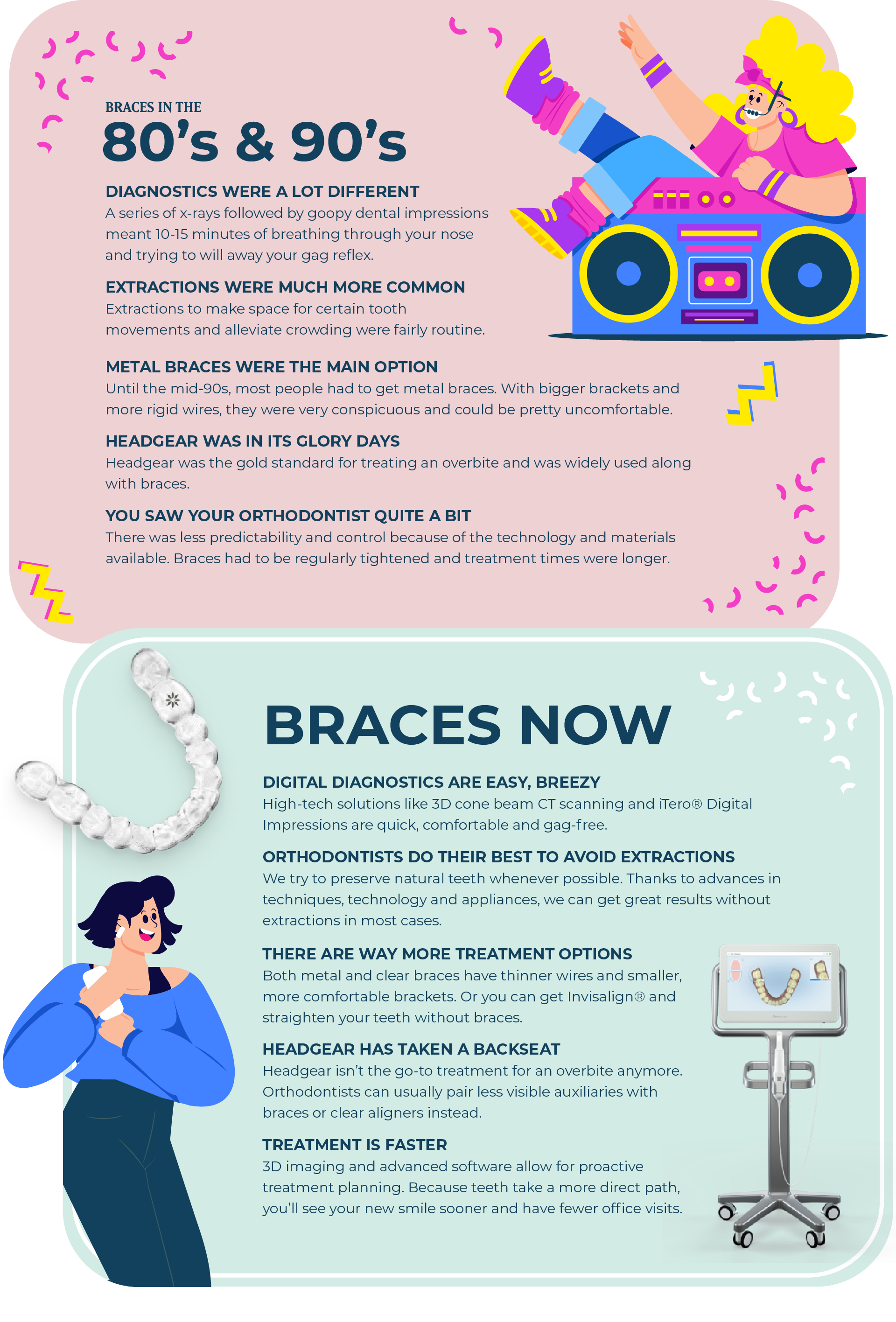If your awkward stage didn’t coincide with wearing a shiny, attention-getting oral appliance, were you really an 80s or early 90s kid? After all, bulky metal braces – sometimes combined with headgear – were pretty much a rite of passage.
Thankfully, orthodontic technology and treatments have come a long way since then. When parents bring their kids into Bird Smiles Orthodontics, they’re often shocked by how different the teeth-straightening experience is today.
Seriously, with Invisalign® Teen, a lot of teenagers don’t even get braces anymore, and bullies have long since moved on from old favorites like “metal mouth,” “brace face” and “train tracks.”
Whether you had braces in the 80s or 90s or you’re just here for the nostalgia, our DC orthodontists are sharing some of the key differences between braces treatment then and now.
Getting Braces in the 80s and 90s
Having diagnostic records taken wasn’t especially pleasant
Braces treatment started with a series of x-rays – cephalometric, panoramic, etc. This was the only way to view your dental and facial structure from different angles.
Next, it was time to take dental impressions. You’d bite down into trays full of putty and hold still while the material set. Then, the assistant would pry the molds off your teeth. If you had a gag reflex, those few minutes felt like a month. Eek.
Extractions were far more common
Pre-braces extractions were performed regularly, in part due to the prevailing treatment philosophy, which focused more on dental alignment and less on biomechanics. In the 80s and 90s, the majority of patients didn’t start treatment before age 12 and early interceptive orthodontics wasn’t as widespread.
Unfortunately, this meant instead of guiding jaw growth to make room for the permanent teeth to come in, space was created after the teeth erupted by pulling them out. It was reactive instead of proactive.
Until the late 90s, metal braces were really the only option
While clear ceramic braces were introduced in the late 80s, they were way more expensive than metal braces at the time and didn’t gain traction until later.
1980s braces were the stereotypical stainless steel variety depicted in pop culture. They involved larger brackets and bands and thicker, more rigid wires. When activated, the rigid wires exerted such a high force that they made it difficult to eat anything but soup for three days and then it felt like there was no activation at all. This peak-and-valley force system was highly uncomfortable. Today, we use memory form wires that are gently and continuously active to straighten teeth with much less force and happier patients.
In the 90s, metal braces still reigned supreme, but they did see some improvements. The brackets got a bit smaller and by the end of the decade, many orthodontists were using heat-activated, titanium alloy archwires. These braces wires were thinner, more flexible and exerted a safer amount of force, providing better aesthetics and comfort.
By the mid-to-late 90s, the cost of clear braces had dropped and more people were getting them. However, the ceramic brackets stained easily and weren’t super durable, so clear braces were usually reserved for older teens and adults.
Headgear was in its glory days
For a long time, headgear was considered the gold standard for treating overbites. Patients would get headgear right before or along with their braces.
And in the 80s, headgear was doing the most. It attached to your braces and had a wire that ran outside of the mouth, as well as a band that went around the back of your head to hold it all together. Fortunately, the contraption did get smaller and more comfortable over time.
Treatment was longer and braces were tightened regularly
As we mentioned, orthodontics was more reactive in the 80s and 90s. This is because orthodontists had to plan treatments using physical models of patients’ mouths. They didn’t have the 3D imaging and treatment planning software that we have today.
With less predictability and control, time was spent correcting unwanted tooth movements after the fact. Treatment lasted longer and, as anyone who had braces in the 80s can attest, it involved frequent and fairly uncomfortable braces tightening appointments.
Getting Braces Now
Digital diagnostics are easy, breezy
At Bird Smiles Orthodontics, we leverage the latest proven technology to make getting diagnostic records quick and painless. For example, instead of taking tons of different x-rays, we can take one scan with our 3D cone beam CT device to see your anatomy from every angle down to the tiniest detail
When it comes to impressions, our iTero® Digital Impression System lets us capture digital images of your teeth and gums with a handheld wand. It’s fast, comfortable and ends with a computerized, 3D model of your mouth.
Advances in orthodontics have significantly cut down on extractions
There are still times when teeth need to be extracted before starting braces treatment, but these cases are few and far between. Over the past several decades, both dentistry and orthodontics have shifted towards saving the natural teeth whenever possible.
And as research and techniques have evolved, we now look at the bigger picture with the goal of balancing aesthetics, function and stability instead of trying to force teeth into a one-size-fits-all idea of alignment.
In kids who are still growing, we can often prevent crowding altogether with interceptive treatment. But even for patients who have all of their permanent teeth, precision planning and a multidisciplinary approach can generally achieve great results without extractions.
There are way more treatment options
Metal braces are still around and still popular, especially with younger patients who tend to like customizing them with colorful elastics. But the wires are thinner, require fewer adjustments and exert gentle force and the brackets are smaller and more comfortable.
Clear braces are similar in price to metal braces these days and are no longer prone to breakage and staining. This makes them a viable option for patients of all ages.
And, of course, Invisalign has been a game changer. The custom aligners are smooth, clear and hardware-free, making them virtually undetectable. Since the aligners are removable, there are no food restrictions, oral hygiene is easy and treatment doesn’t interfere with things like playing sports.
When it comes to the cost of Invisalign vs. braces, they’re the same price at our DC orthodontics practice. This ensures we can provide you with the best possible treatment without finances being a factor.
Headgear has taken a backseat to more under-the-radar options
Headgear still exists today, but it’s not commonly used. There are other options for most cases, including auxiliaries that work with braces or clear aligners to improve the bite from inside of the mouth.
Treatment is faster, more comfortable (really!) and convenient
Digital orthodontics has transformed how we straighten teeth. Myths like braces being painful are often based on the experience of having braces in the 80s or 90s.
With digital diagnostics and treatment planning software, Dr. Sonia Talley and Dr. Katie Clark can manipulate 3D simulations of your mouth to compare different outcomes and troubleshoot potential problems in advance. This precise approach helps teeth take a more direct and predictable path to their ideal places, giving you better results in less time.
Modern Braces in Washington, DC
While having braces in the 80s and early 90s was no picnic, the payoff was a straighter, healthier smile. Thanks to advances in orthodontics, we can achieve even more dramatic, stable results comfortably, conveniently and aesthetically.
Whether you’re interested in braces or Invisalign, Bird Smiles Orthodontics can help. Schedule a complimentary consultation with an orthodontist in DC today!





